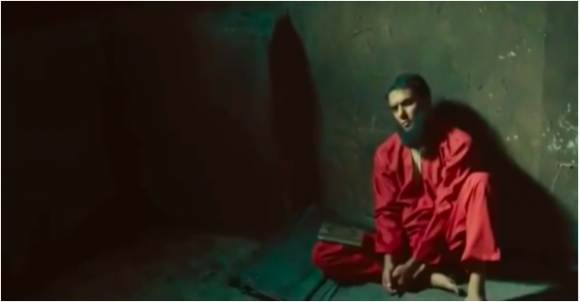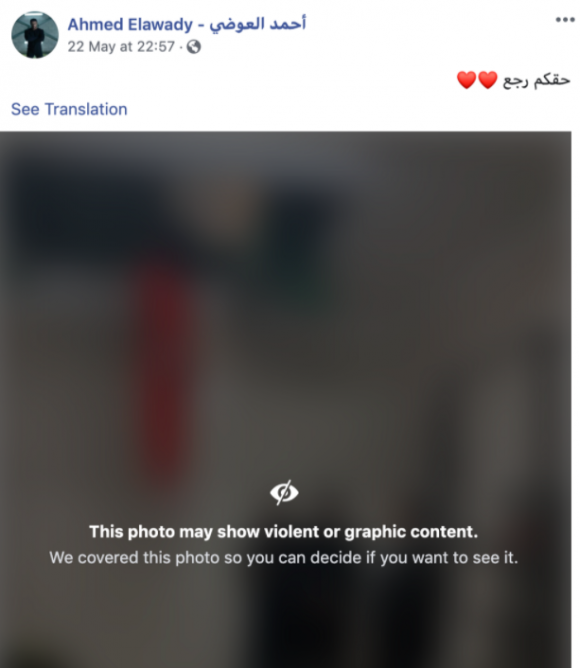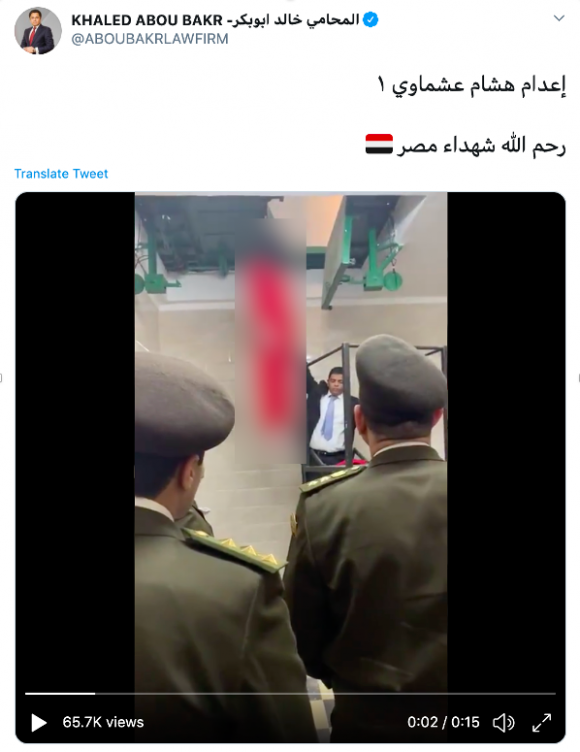

Coordinated Leak: Egypt's Primetime Execution Video
Overview
In the early hours of Saturday May 23, 2020, graphic photos and videos of executed Egyptian terrorist Hesham Ashmawy were leaked to social media by pro-regime influencers.1 The timing of the leak appears to have been deliberately synced with the narrative arc of a primetime Ramadan television series, produced and funded by Egypt’s security services.2 A detailed forensic analysis of the leak suggests the photos and videos were released as part of a coordinated propaganda campaign aimed at the domestic Egyptian audience in order to aggrandize Egypt’s military and scapegoat religious fundamentalism.
- 1 Joey Shea, “Egyptian execution video leaked in campaign coordinated with Ramadan soap opera,” Medium, June 3, 2020, https://medium.com/@joey.s.shea/egyptian-execution-video-leaked-in-propaganda-campaign-coordinated-with-ramadan-soap-opera-4925c7ee32ed.
- 2 Ramadan television series are an important cultural phenomenon in Egypt and the Arab world during the Ramadan holiday and are hugely important in Egypt’s TV market. These drama series are usually watched after iftar and have new episodes throughout the 30 day religious holiday.
STAGE 1: Manipulation Campaign Planning and Origins
Production on the TV series El Ekhteyar (The Choice) began in mid-2019 and was scheduled to be shown during Ramadan 2020. Tamer Morsi, the CEO of Synergy Production, produced the show in collaboration with the Egyptian Military’s s Morale Affairs Department,1 which has been called the military’s propaganda agency.2 The series was released on April 24, 2020 and ran throughout Ramadan 2020.3
The Choice is a biopic of Ahmed Saber el-Mansy, an Egyptian special forces member who was killed by ISIS in a 2017 North Sinai attack.4 The series also profiles Hesham Ashmawy, another former member of the Egyptian special forces.5 Dismissed by the military in 2011 for his increasingly radical religious views, Ashmawy was accused of being involved in a string of high-profile terrorist attacks throughout Egypt, including the 2015 assassination of public prosecutor Hisham Barakat. Ashmawy was infamously dubbed “Egypt’s most wanted man” by the Egyptian press. He was captured in Libya, extradited back to Egypt and executed on March 4, 2020.6 The Choice juxtaposes the “traitorous” Ashmawy with el-Mansy’s tragic and heroic bravery and uses two characters to personify the fight against terrorism as an eternal battle between good and evil.7 The show uses Egypt’s insurgency to exploit the wedge issue of religious fundamentalism by demonising Islamic fundamentalism though an association with terrorism and, in so doing, pitting the wider population against anyone in this social identity group or affiliated political party.8 The government-produced drama targets Egypt’s domestic audience by celebrating the heroism of the military while scapegoating religious fundamentalism.9
The Choice was produced by Synergy Productions, a film production company acquired by Egyptian Media Group in 2016.10 Egyptian Media Group is owned by Eagle Capital, an investment firm reportedly11 owned and operated by Egypt’s General Intelligence Service (GIS).12 Egyptian Media Group is the largest media conglomerate in Egypt, controlling multiple TV networks, newspapers, and production companies. The newspaper Al-Youm Al-Saaba and TV station ON TV – both of which were involved in this manipulation campaign – are owned by Egyptian Media Group.13
- 1 Al-Shaer, Adham, Hadeer El-Mahdawy, Karoline Kamel, Leila Arman, Mohamed Ashraf Abu Emaira, Mohamed Tarek, Mostafa Mohie, Nada Arafat, Omar Said, Salah El Oweidy, Sara Seif Eddin, Yasmin El-Rifae and Yasmine Zohdi, “Ramadan TV 2020: What’s worth tolerating this year?,” Mada Masr, May 7, 2020, https://madamasr.com/en/2020/05/07/feature/culture/ramadan-tv-2020-whats-worth-tolerating-this-year/.
- 2 Bel Trew, “Welcome to the Department of Morale Affairs,” Foreign Policy, January 15, 2014, accessed via the Internet Archive on December 19,2020, https://web.archive.org/web/20201218191513/https://foreignpolicy.com/2014/01/15/welcome-to-the-department-of-morale-affairs/.
- 3 Al-Masry Al-Youm, “Egyptian television channels release 2020 Ramadan series list,” April 15, 2020, https://egyptindependent.com/egyptian-television-channels-release-2020-ramadan-series-list/.
- 4 Egypt Today Staff, “Profile: Ahmed el-Mansy…commander of Sa’ka Forces martyr,” Egypt Today, July 10, 2017, https://www.egypttoday.com/Article/1/10952/Profile-Ahmed-el-Mansy%E2%80%A6commander-of-Sa%E2%80%99ka-Forces-martyr.
- 5 Mary Aravanis, “Ramadan Series 2020: Our Top 3 Must-Watch Ramadan Shows of the Year,” May 11, 2020, https://egyptianstreets.com/2020/05/11/ramadan-series-2020-our-top-3-must-watch-ramadan-shows-of-the-year/.
- 6 “Egypt sentences notorious militant Hisham Ashmawy to death,” AFP, March 2, 2020, https://www.france24.com/en/20200302-egypt-sentences-notorious-militant-hisham-ashmawy-to-death.
- 7Mohamed Abdel-Hadi, “A Ramadan series brings Egypt’s fight against extremists to TV screens,” The Arab Weekly, April 30, 2020, https://thearabweekly.com/ramadan-series-brings-egypts-fight-against-extremists-tv-screens.
- 8 In Egypt, political parties have been effectively banned. Based on the overall narrative, the campaign was likely targeting religious fundamentalism and Islamists, and to a subtle extent, the Muslim Brotherhood. These groups somewhat blur the boundaries between and . Because of the political situation in the country, there are effectively no political parties that represent these groups. The Muslim Brotherhood has been designated a terrorist organization by the regime and the group's political party affiliate, the Freedom and Justice Party, has been dissolved.
- 9 The narrative arc of El Ekhtayar tries to draw a link between the Muslim Brotherhood and extremist groups in North Sinai. While there is little evidence of a direct link between the Brotherhood and these militant groups, this insinuation coincides with one of the most enduring propaganda narratives of this regime: namely, that the Muslim Brotherhood is a terrorist organization intent on destabilizing the country and destroying national unity. For more information, see: “The Egyptian government’s favourite scapegoat,” The Economist, May 9, 2019, https://www.economist.com/middle-east-and-africa/2019/03/09/the-egyptian-governments-favourite-scapegoat.
- 10 “Egyptian Media Group,” Reporters Without Borders, https://egypt.mom-rsf.org/en/owners/companies/detail/company/company/show/egyptian-media-group/.
- 11MEE and agencies, “Egyptian intelligence services front acquires leading media houses: Reports,” Middle East Eye, December 29, 2017, https://www.middleeasteye.net/news/egyptian-intelligence-services-front-acquires-leading-media-houses-reports .
- 12 Hossam Bahgat, “Looking into the latest acquisition of Egyptian media companies by general intelligence,” Mada Masr, December 21, 2017, https://madamasr.com/en/2017/12/21/feature/politics/looking-into-the-latest-acquisition-of-egyptian-media-companies-by-general-intelligence/.
- 13“Egyptian Media Group.”
STAGE 2: Seeding Campaign Across Social Platforms and Web
On Friday May 22, episode 29 of The Choice aired at 9 p.m. in Cairo.1 The episode covers Ashmawy’s capture in Libya and extradition to Egypt, mixing dramatized scenes with real-footage of Ashmawy’s rendition. The end of the episode shows Ashmawy’s interrogator defiantly leaving the terrorist alone in his cell. The screen turns black and the final moments of the episode show a real video of Ashmawy, moments before his execution on March 4. Framed by two balaclava-clad guards, he is invited to speak his last words.
- 1 Samar Abdullah, “The moment of execution of the terrorist Hisham Ashmawy (video),” Al Dostor, May 22, 2020, https://www.dostor.org/3095359.
The episode concluded around 10 p.m. in Cairo. Two hours later, at 11:57 p.m. UTC+2, the actor and influencer Ahmed Elawady, who plays Ashmawy in the TV series, posted a graphic photo to his Facebook page.1 The photo appears to show Ashmawy’s hanging body, immediately after his execution; in some frames, Ashmay’s face is clearly visible and identifiable. Egyptian authorities had previously confirmed Ashmawy’s successful execution on March 4, 2020,2 but had not released any photos or videos through official channels, nor had any images leaked. It is unclear how Elawady came into possession of the photo. He does not offer any explanation in his post. State-owned media treated the image as authentic.
- 1 Ahmed Elawady, “حقكم رجع,” , May 22, 2020, https://www.facebook.com/Ahmed.Elawady.Official/posts/3014982678557256.
- 2 Leen Alfaisal, “Egyptian officer-turned-extremist Hesham Ashmawy executed: Military,” Al Arabiya, March 4, 2020, https://english.alarabiya.net/en/News/middle-east/2020/03/04/Egyptian-officer-turned-extremist-Hesham-Ashmawy-executed-Military.
Two hours after Elawady posted the first photo of Ashmawy, prominent Egyptian TV host, lawyer, and influencer Khaled Abou Bakr tweeted two short video clips to his Twitter feed, which had over 750k followers the week he tweeted the videos.1 The clips were posted within a minute of each other (2:13 a.m. UTC+2 and 2:13 a.m. UTC+2 on March 23).2 The videos appear to show Ashmawy immediately after his execution. In the first, his body is hanging while an official checks his pulse; the second shows Ashmawy’s corpse lying on a rug on the floor. The initial photo posted by Elawady shows only Ashmawy’s hanging corpse and does not include the pulse-checking official. This suggests Elawady’s image is not a screenshot or a still taken from the videos tweeted by Abou Bakr; it is an entirely separate image.
Khaled Abou Bakr is an Egyptian television host on ON TV, which is owned by Egyptian Media Group; it is also the same channel airing The Choice.3 He reported on Ashmawy’s rendition in 2019 for the channel, and real footage of his coverage of the event is featured in episode 29 of The Choice.4
Al-Youm Al-Saaba, a prominent Egyptian newspaper also owned by Egyptian Media Group, reported on Elawady’s Facebook post.5 The article states: “star Ahmed Elawady posted real snapshots of the execution of the terrorist Hesham Ashmawy, through his personal Facebook account. In the video published by Elawady, the moment of the execution of the terrorist Hesham Ashmawi, and he is shown in red clothes.”6 The reporting in the article is curious, because Elawady didn’t post any videos — he only posted a photo. Moreover, the photo on his Facebook page does not have any officers in view, demonstrating that it is not a screenshot from Abou Bakr’s tweeted video clips.
In the article posted by Al-Youm Al-Saaba, there are three videos embedded from the paper’s YouTube channel. Two videos are exact copies of those from Abou Bakr’s tweets; their timestamps show that they were posted after Abou Bakr tweeted. But the third video posted to Al-Youm Al-Saaba’s YouTube account was uploaded at 3:32 a.m. UTC+2 and shows Ashmawy alive, immediately before his execution. Abou Bakr eventually tweeted the same video, at 3:50 a.m. UTC+2 — 18 minutes after the video was first posted to Al-Youm Al-Saaba’s YouTube account.
Between Elawady’s Facebook posts, Abou Bakr’s Twitter videos, and Al-Youm Al-Saaba’s YouTube account, it appears that multiple sources had access to different videos and photos of Ashmawy’s execution. The staggered publishing timeline shows that one source did not simply copy from the other. All three published these previously unseen and apparently authentic images and videos hours after Ashmawy’s capture and execution storyline had aired on a primetime Ramadan TV series.
Twitter data for the Arabic hashtag #هشام_عشماوي (#Hesham_Ashmawy) also suggests coordination. A time-lapse graph of the hashtag shows a sharp spike in tweets in the hours after Elawady posted the first photo to his Facebook. A closer look at some of the accounts responsible for this spike in traffic reveals suspicious similarities in style and form. This small sample shows similar motifs and profile images among accounts responsible for the trending hashtag: images of Mohammad Bin Salman, the Egyptian military, and many accounts that have no uploaded profile picture or background image. The data from the hashtag does not overwhelmingly indicate inauthentic behaviour, but suggests coordination by networked factions of regime loyalists and other pro-regime partisans. Combined with the timing of the “leaked” images and videos coinciding with Ashmawy’s character arc in the TV series, it appears this was part of a coordinated effort.
- 1 Khaled Abou Bakr (@Aboubakrlawfirm), “Execution of Hisham Ashmawy 1 God bless the martyrs of Egypt,” , May 23, 2020, https://twitter.com/ABOUBAKRLAWFIRM/status/1263986401005142031.
- 2 Khaled Abou Bakr (@Aboubakrlawfirm), “The execution of Hisham Ashmawi 2 May God have mercy on our heroes,” Twitter, May 23, 2020, https://twitter.com/ABOUBAKRLAWFIRM/status/1263986633633824774.
- 3“Egyptian Media Group.”
- 4 ON Drama, “Khaled Abu Bakr conducts the first dialogue with the terrorist Hisham Ashmawi inside the plane,” , May 29, 2019, https://www.youtube.com/watch?v=SXf93EcOuvs.
- 5 Asir Ahmed, “Video .. Ahmed Al-Awadi publishes the moments of the execution of the terrorist Hisham Ashmawy: "The best trouble is upon you",” Al-Youm Al-Saaba, May 23, 2020, https://www.youm7.com/story/2020/5/23/%D9%81%D9%8A%D8%AF%D9%8A%D9%88-%D8%A3%D8%AD%D9%85%D8%AF-%D8%A7%D9%84%D8%B9%D9%88%D8%B6%D9%89-%D9%8A%D9%86%D8%B4%D8%B1-%D9%84%D8%AD%D8%B8%D8%A7%D8%AA-%D8%A5%D8%B9%D8%AF%D8%A7%D9%85-%D8%A7%D9%84%D8%A5%D8%B1%D9%87%D8%A7%D8%A8%D9%89-%D9%87%D8%B4%D8%A7%D9%85-%D8%B9%D8%B4%D9%85%D8%A7%D9%88%D9%89-%D8%A3%D8%AD%D9%84%D9%89/4789145.
- 6 Ahmed, “Video .. Ahmed Al-Awadi publishes the moments of the execution of the terrorist Hisham Ashmawy: 'The best trouble is upon you.'”
STAGE 3: Responses by Industry, Activists, Politicians, and Journalists
Because the operation involved the active participation of multiple Egyptian media organizations, stages two and three overlapped. Coverage of the leak in the Egyptian press included those outlets – Al-Youm Al-Saaba, namely – that contributed to the campaign by originally posting and actively spreading the execution content. The leak also garnered further media exposure by other Egyptian press outlets that reported on the final moments of episode 29 of The Choice and actor Ahmed Elawady’s Facebook post with a tone of triumph.1 State-owned and controlled media continued to report on the subsequent episodes of The Choice.
Egyptian human rights advocates, security experts, and commentators expressed their outrage and disgust on social media. Bahey Hassan, the director of the Cairo Institute for Human Rights Studies, called the leak barbaric and degenerative, comparing it to the leaked footage of the execution of Saddam Hussein.2 An expert in Egyptian security and defense also warned that the leak “set a very dangerous precedent.”3 Haytham Abou Khalil, an exiled TV presenter based in Turkey, called the leak a “serious error” and argued it would not act as a deterrent for terrorists.4 Many of these commentators and other news outlets attributed the campaign to Egyptian security services with strong confidence, given GIS’s extraordinary centralized control over Egypt’s media industry.5
- 1 Sada Elbalad, “My responsibility - the moment the death sentence was executed against the terrorist Hisham Ashmawy,” YouTube, May 23, 2020, https://www.youtube.com/watch?v=ZBComIcZOmw.
- 2 Bahey eldin Hassan (@BaheyHassan), “Barbarism and degeneration,” Twitter, May 23, 2020, https://twitter.com/BaheyHassan/status/1264110675057672192.
- 3 Egypt Defence Review (@EgyptDefReview), “Very disturbing footage depicting the state execution,” Twitter, May 23, 2020, https://twitter.com/EgyptDefReview/status/1264062023962370048.
- 4 Haytham Abokhalil (@haythamabokhal1), “He published a video and photos of the execution,” Twitter, May 23, 2020, https://twitter.com/haythamabokhal1/status/1264010226304507905.
- 5 Ahmed Hussain, “Egypt: Leaked video clip of the execution of the death sentence of Hisham Ashmawy,” Alhurra, May 23, 2020, https://www.alhurra.com/arabic-and-international/2020/05/23/%D9%85%D8%B5%D8%B1-%D8%AA%D8%B3%D8%B1%D9%8A%D8%A8-%D9%85%D9%82%D8%B7%D8%B9-%D9%81%D9%8A%D8%AF%D9%8A%D9%88-%D8%AA%D9%86%D9%81%D9%8A%D8%B0-%D8%AD%D9%83%D9%85-%D8%A7%D9%84%D8%A5%D8%B9%D8%AF%D8%A7%D9%85-%D9%81%D9%8A-%D9%87%D8%B4%D8%A7%D9%85-%D8%B9%D8%B4%D9%85%D8%A7%D9%88%D9%8A.
STAGE 4: efforts
Some international covered the leaks more critically.1 BBC and CNN Arabic both emphasized that the leaked image and videos sparked controversy on social media, with some users celebrating and others criticizing the leaks.2 This critical press, though notable, did little to curtail the dissemination and amplification of the leaks.
There were no major alterations to the availability of information in response to this operation. While Ahmed Elawady’s photo was labeled early by Facebook via a sensitive content label, Ashmawy’s execution videos and photos were initially not removed by any of the major social media companies. This content remains widely available on Twitter, YouTube, and Facebook at the time of writing in December 2020.
However, the videos embedded in the original Al-Youm Al-Saaba article have since become unavailable.3 While the content is still viewable through many other YouTube accounts, the account that first uploaded them in the early hours of May 23 is no longer accessible. It is unclear if the videos were removed because they violated YouTube’s terms of service, or because the account to which they were uploaded was deleted.
The videos embedded in the Al-Youm Al-Saaba article were first uploaded to a YouTube account called “Mubasher Youm7”, meaning “Daily Live.” In May, this account shared branding similar to Al-Youm Al-Saaba and appeared to be presenting itself as an official “live” account affiliated with Al-Youm Al-Saaba. It is unclear if this account was actually affiliated with Al-Youm Al-Saaba --- it had only 667 subscribers when the account was viewed in May. Al-Youm Al-Saaba has another verified YouTube account, “VideoYoum7”, with over 3 million subscribers that remains active at the time of writing; the account does not contain any raw footage from the leaked videos.4
- 1 “Controversy after an Egyptian actor published photos of the moment of execution of Hisham Ashmawy,” CNN Arabic, May 23, 2020, https://arabic.cnn.com/middle-east/article/2020/05/23/egyptian-actor-publishes-pictures-ashmawy-execution.
- 2 “The spread of videos and photos of the execution of Hisham Ashmawy,” BBC Arabic, May 25, 2020, https://www.bbc.com/arabic/tv-and-radio-52795634.
- 3 Ahmed, “Video .. Ahmed Al-Awadi publishes the moments of the execution of the terrorist Hisham Ashmawy: 'The best trouble is upon you.'”
- 4 VideoYoum7, YouTube, https://www.youtube.com/user/MubasherYoum7.
STAGE 5: Adjustments by campaign operators
Campaign operators do not seem to have adapted their tactics or techniques in response to the muted mitigation efforts. After the final episode of the series aired, Tamer Morsi and Synergy Productions announced El Ekhteyar 2, which will debut during Ramadan 2021.1
Egypt’s media industry remains centrally controlled and multiple platforms within this ecosystem – production companies, television channels, newspapers, influential social media accounts – continue to produce, and spread pro-military propaganda. There have been no fundamental changes to these dynamics, nor incentives to change tactics, since the May 2020 operation.
- 1 “Synergy announced second season of El-Ekhteyar TV series in 2021,” Ahram Online, May 25, 2020, http://english.ahram.org.eg/NewsContent/5/159/369920/Arts--Culture/Entertainment/Synergy-announces-second-season-of-ElEkhteyar-TV-s.aspx.
Cite this case study
Joey Shea, "Coordinated Leak: Egypt's Primetime Execution Video," The Media Manipulation Case Book, July 7, 2021, https://casebook-static.pages.dev/case-studies/coordinated-leak-egypts-primetime-execution-video.



